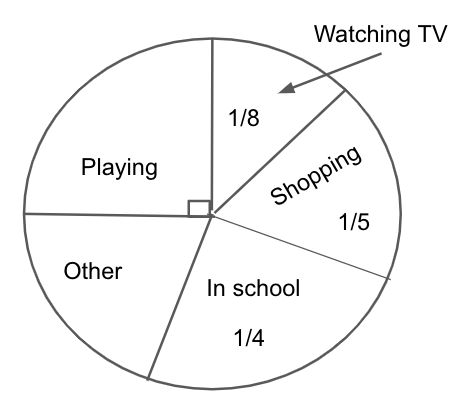
The given pie chart shows how Prabhat spent his time on a certain day.
a) How much time did he spend in playing?
b) How much time did he spend in school?
c) How much time did he spend in other activities?


Answer
501k+ views
1 likes
Hint: Consider that the total time in a day is 24 hours and total circle has a probability 1. So, first we will compute the time spend by him in different activities by multiplying probability of the particular activity by 24 hours. Then we will use the find the time spend by him in the other activities from the given pie chart using the formula,
Complete step by step answer:
We know that the total time in a day is 24 hours.
We are given that the probability of Prabhat spends while watching TV is
Since the region for playing covers the 90 degrees, the probability Prabhat spends while playing is
(i) We are given that Prabhat spends
We will now find the time spent by him playing in a day.
Hence, time spent by him in playing is 6 hours.
(ii) We are given that Prabhat spends
We will now find the time spend by him in school in a day by multiplying the probability of playing with 24, we get
Hence, the time spent by him in school is 6 hours.
(iii) We know that the sum of all the probabilities of the circle is 1.
We will now find the time spend by him in the other activities from the given pie chart using the formula,
Using the probabilities of the time spent by Prabhat in school, playing, watching TV and sleeping in the above formula, we get
Thus, Prabhat spends
We will now find the time spend by him in other activities in a day.
Hence, the time spends by him in other activities is
Note: In solving these types of questions, students should first carefully read the question and the pie chart. One should know that the probability is simply how likely something is to happen. Some students take the time as 1 day, which is wrong. So we must know that the total time in a day is 24 hours and the total circle has a probability of 1. When we have written that Prabhat spends the time in a circle, it means we have to evaluate the product of the probability of the particular activity and 24 hours to find the time spend by him.
Complete step by step answer:
We know that the total time in a day is 24 hours.
We are given that the probability of Prabhat spends while watching TV is
Since the region for playing covers the 90 degrees, the probability Prabhat spends while playing is
(i) We are given that Prabhat spends
We will now find the time spent by him playing in a day.
Hence, time spent by him in playing is 6 hours.
(ii) We are given that Prabhat spends
We will now find the time spend by him in school in a day by multiplying the probability of playing with 24, we get
Hence, the time spent by him in school is 6 hours.
(iii) We know that the sum of all the probabilities of the circle is 1.
We will now find the time spend by him in the other activities from the given pie chart using the formula,
Using the probabilities of the time spent by Prabhat in school, playing, watching TV and sleeping in the above formula, we get
Thus, Prabhat spends
We will now find the time spend by him in other activities in a day.
Hence, the time spends by him in other activities is
Note: In solving these types of questions, students should first carefully read the question and the pie chart. One should know that the probability is simply how likely something is to happen. Some students take the time as 1 day, which is wrong. So we must know that the total time in a day is 24 hours and the total circle has a probability of 1. When we have written that Prabhat spends the time in a circle, it means we have to evaluate the product of the probability of the particular activity and 24 hours to find the time spend by him.
Recently Updated Pages
Master Class 4 Maths: Engaging Questions & Answers for Success

Master Class 4 English: Engaging Questions & Answers for Success

Master Class 4 Science: Engaging Questions & Answers for Success

Class 4 Question and Answer - Your Ultimate Solutions Guide

Master Class 11 Economics: Engaging Questions & Answers for Success

Master Class 11 Business Studies: Engaging Questions & Answers for Success

Trending doubts
Give 10 examples of unisexual and bisexual flowers

Draw a labelled sketch of the human eye class 12 physics CBSE

Differentiate between homogeneous and heterogeneous class 12 chemistry CBSE

a Tabulate the differences in the characteristics of class 12 chemistry CBSE

Why is the cell called the structural and functional class 12 biology CBSE

Differentiate between insitu conservation and exsitu class 12 biology CBSE




